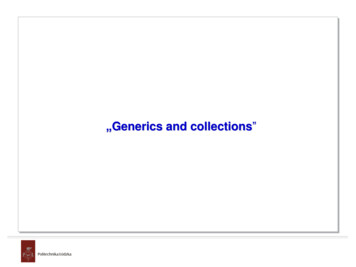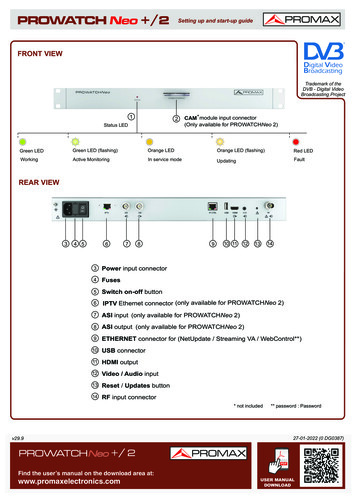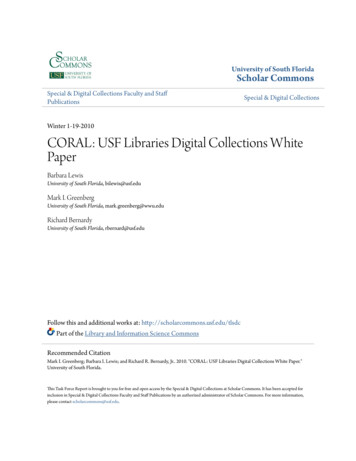
Transcription
„Generics and collections”
Generics and collectionsGenerics From JDK 1.5.0 They are similar to C templates They allow to eliminate runtime exceptions related to impropercasting (ClassCastException)
Generics and collectionsTraditional approachpublic class Box {public class BoxDemo1 {private Object object;public static void main(String[] args) {public void add(Object object) {// Box for integers (?)this.object object;Box integerBox new Box();}integerBox.add(new Integer(10));public Object get() {// we are casting to Integer. Why?return object; }Integer someInteger Integer);}}
Generics and collectionsTraditional approach (2)public class BoxDemo2 {public static void main(String[] args) {// Box for integers (?)Box integerBox new Box();// In large application modified by one programmer:integerBox.add("10"); // note how the type is now String// And in the second written by a different programmer// Checked exception or runtime exception ?Integer someInteger nteger);}}
Generics approachpublic class Box T {private T t;// T stands for "Type"public class BoxDemo3 {public static void main(String[] args) {Box Integer integerBox newBox Integer ();public void add(T t) {integerBox.add(new Integer(10));Integer someInteger integerBox.get();// no cast!System.out.println(someInteger);this.t t;}public T get() {return t;}}Generics and collections}}
Generics and collectionsGenerics approach (2)In case of adding an incompatible type to the box:BoxDemo3.java:5: add(java.lang.Integer) in Box java.lang.Integer cannot be applied to (java.lang.String)integerBox.add("10"); 1 error
Generics and collectionsThe DiamondFrom Java SE 7:Box Integer integerBox new Box ();
Generics and collectionsNaming conventionsThe most commonly used type parameter names are:E - Element (used extensively by the Java CollectionsFramework)K - KeyN - NumberT - TypeV - ValueS,U – other typesPresented by Bartosz SakowiczDMCS TUL
Generics and collectionsBounded type parameterspublic class Box T { public U extends Number void inspect(U u){System.out.println("T: " t.getClass().getName());System.out.println("U: " u.getClass().getName());}public static void main(String[] args) {Box Integer integerBox new Box Integer ();integerBox.add(new Integer(10));integerBox.inspect("some text"); // error: this is still String! } }// extends is used in a general sense to mean either "extends" (as inclasses) or "implements" (as in interfaces)Presented by Bartosz SakowiczDMCS TUL
Generics and collectionsBounded type parameters (2)public class NaturalNumber T extends Integer {private T n;public NaturalNumber(T n) {this.n n;}public boolean isEven() {return n.intValue() % 2 0;} // . }The isEven method invokes the intValue method defined in the Integer classthrough n.In this simple case declaration could be also just NaturalNumber Integer ,but extends can be applied also to interfaces as well it can have manyarguments, e.g. extends A & B & C. Question: What are A, B, C?Answer: Only one of them can be class and in this caseit must be first argument of extends.Presented by Bartosz SakowiczDMCS TUL
Generics and collectionsInheritance and subtypes1)Object someObject new Object();Integer someInteger new Integer(10);someObject someInteger; // OK ?2)public void someMethod(Number n) { /* . */ }someMethod(new Integer(10)); // OK ?someMethod(new Double(10.1)); // OK ?3)Box Number box new Box Number ();box.add(new Integer(10)); // OK ?box.add(new Double(10.1)); // OK ?Answer:Everything is ok!Presented by Bartosz SakowiczDMCS TUL
Generics and collectionsInheritance and subtypes (2)Consider this:public void boxTest(Box Number n) { /* . */ }Can you pass argument Box Integer ?Answer: No.Presented by Bartosz SakowiczDMCS TUL
Everything is an object!
Overriding equals() methodIf you want objects of your class to be used as keys fora hashtable (or as elements in any data structure hingthenyoufor—and/ormustoverrideequals() so that two different instances can beconsidered the same.
The equals() ContractPulled straight from the Java docs, the equals() contract says: It is reflexive. For any reference value x, x.equals(x) shouldreturn true. It is symmetric. For any reference values x and y, x.equals(y)should return true if and only if y.equals(x) returns true. It is transitive. For any reference values x, y, and z, ifx.equals(y) returns true and y.equals(z) returns true, thenx.equals(z) must return true.
The equals() Contract It is consistent. For any reference values x and y,multiple invocations of x.equals(y) consistently returntrue or consistently return false For any non-null reference value x, x.equals(null)should return false.
Understanding Hashcodes
Now that we know that two equal objects musthave identical hashcodes, is the reverse true? Dotwo objects with identical hashcodes have to beconsidered equal?
The hashCode() ContracthashCode() contract: Whenever it is invoked on the same object more thanonce during an execution of a Java application, thehashCode() method must consistently return the sameinteger, provided that no information used in equals()comparisons on the object is modified.
The hashCode() Contract If two objects are equal according to theequals(Object) method, then calling thehashCode() method on each of the two objectsmust produce the same integer result. It is NOT required that if two objects are unequalaccording to the equals(java.lang.Object)method, then calling the hashCode() method oneach of the two objects must produce distinctinteger results.
Problem1.Is the following implementation of hashCode valid:int hashCode() { return 1; }Yes, it is. But it is sloooooooow.
Problem1.Give an object some state (assign values to its instancevariables).2.Put the object in a HashMap, using the object as a key.3.Save the object to a file using serialization withoutaltering any of its state.4.Retrieve the object from the file through deserialization.5.Use the deserialized (brought back to life on the heap)object to get the object out of the HashMap.
Generics and collectionsCollections overview A collection (sometimes called a container) is simply anobject that groups multiple elements into a single unit. Collections are used to store, retrieve and manipulate data,and to transmit data from one method to another. Collections typically represent data items that form anatural group, like a poker hand (a collection of cards), a mailfolder (a collection of letters), or a telephone directory (acollection of name-to-phone-number mappings).
Generics and collectionsCollections frameworkA collections framework is a unified architecture forrepresenting and manipulating collections. All collectionsframeworks contain three things: Interfaces: abstract data types representing collections.Interfaces allow collections to be manipulated independently ofthe details of their representation. Implementations: concrete implementations of the collectioninterfaces. Algorithms: methods that perform useful computations, likesearching and sorting, on objects that implement collectioninterfaces.
Generics and collectionsCore collections interfacesThe core collection interfaces are the interfaces used tomanipulate collections, and to pass them from one method toanother. The basic purpose of these interfaces is to allowcollections to be manipulated independently of the details oftheir representation:
The interface and class hierarchy for collections
Generics and collectionsOptional operations To keep the number of core collection interfacesmanageable, the Java platform doesn't provide separateinterfaces for each variant of each collection type. Instead, the modification operations in each interface aredesignated optional — a given implementation may elect not tosupport all operations. If an unsupported operation is invoked, a collection throwsan UnsupportedOperationException. Implementations are responsible for documenting which ofthe optional operations they support. All of the Java platform's general-purpose implementationssupport all of the optional operations.
Generics and collectionsThe Collection interfaceA Collection represents a group of objects, known as its elements. Theprimary use of the Collection interface is to pass around collections ofobjects where maximum generality is desired. The Collection interface isshown below:public interface Collection E extends Iterable E {int size();boolean isEmpty();boolean contains(Object element);boolean add( E element);//optionalboolean remove(Object element); //optionalIterator E iterator();
Generics and collectionsThe Collection interface(2)boolean containsAll(Collection ? c);boolean addAll(Collection ? extends E c); //optionalboolean removeAll(Collection ? c);boolean retainAll(Collection ? c);//optional//optional// Removes from the target Collection all of its elements that are not alsocontained in the specified Collection.void clear();Object[] toArray(); T T[] toArray(T[] a);}//optional
Generics and collectionsIteratorIterator is very similar to an Enumeration , but allows the caller to removeelements from the underlying collection during the iteration with welldefined semantics. The Iterator interface:public interface Iterator E {boolean hasNext();E next();void remove(); //optional}Traversing collections:for (Object o : collection)System.out.println(o);
Generics and collectionsIterator - examplestatic void filter(Collection c) {for (Iterator i c.iterator(); i.hasNext(); )if (!cond(i.next()))i.remove();} //Another example:java.util.Map result; //Creation somewhere else.if (result! null) {java.util.Iterator i result.entrySet().iterator();while(i.hasNext()) {java.util.Map.Entry entry (java.util.Map.Entry)i.next();debug(entry.getKey() " " entry.getValue()); }}
Generics and collectionsThe Set InterfaceA Set is a Collection that cannot contain duplicate elements.Set models the mathematical set abstraction. The Set interfaceextends Collection and contains no methods other than thoseinherited from Collection. It adds the restriction that duplicateelements are prohibited.Two Set objects are equal if theycontain the same elements.Usage of Set example:Suppose you have a Collection, c, and you want to createanother Collection containing the same elements, but with allduplicates eliminated. The following one-liner does the trick:Collection T noDups new HashSet T (c);
Generics and collectionsThe Set Interface usage examplepublic class FindDuplicates {public static void main(String[] args) {Set String s new HashSet String ();for (String a : args)if (!s.add(a))System.out.println("Duplicate detected: " a);System.out.println(s.size() " distinct words: " s);}}
Generics and collectionsThe List InterfaceA List is an ordered Collection (sometimes called a sequence).Lists may contain duplicate elements.The JDK contains two general-purpose List implementations.ArrayList , which is generally the best-performingimplementation, and LinkedList which offers betterperformance under certain circumstances.Two List objects are equal if they contain the same elements inthe same order.
Generics and collectionsThe List Interface(2)public interface List E extends Collection E {E get(int index);E set(int index, E element);boolean add(E element);//optional//optionalvoid add(int index, E element); //optionalE remove(int index);//optionalboolean addAll(int index,Collection ? extends E c); //optionalint indexOf(Object o);int lastIndexOf(Object o);ListIterator E listIterator();ListIterator E listIterator(int index);List E subList(int from, int to);}
Generics and collectionsThe queue interfacepublic interface Queue E extends Collection E {E element();boolean offer(E e);E peek();E poll();E remove();}
Generics and collectionsThe Deque interfaceDeque is a double-ended-queue:Type of OperationInsertRemoveExamineFirst Element (Beginningof the Deque First()getFirst()peekFirst()Last Element (End ofthe Deque t()getLast()peekLast()
Generics and collectionsThe queue interface (2)Each Queue method exists in two forms:(1) one throws an exception if the operation fails(2) the other returns a special value if the operation fails (eithernull or false, depending on the operation).Throws exceptionReturns special neelement()peek()
Generics and collectionsThe Map InterfaceA Map is an object that maps keys to values. A map cannot containduplicate keys: Each key can map to at most one value. Two Map objectsare equal if they represent the same key-value mappings.The most useful methods:public interface Map K,V {V put(K key, V value);V get(Object key);V remove(Object key);boolean containsKey(Object key);boolean containsValue(Object value); }
Generics and collectionsThe Comparable InterfaceThe Comparable interface consists of a single method:public interface Comparable T {public int compareTo(T o);}The compareTo method compares the receiving object withthe specified object, and returns a negative integer, zero, or apositive integer as the receiving object is less than, equal to, orgreater than the specified Object.
Generics and collectionsThe Comparator InterfaceA Comparator is an object that encapsulates an ordering. Likethe Comparable interface, the Comparator interface consists ofa single method:public interface Comparator T {int compare(T o1, T o2);}The compare method compares its two arguments, returning anegative integer, zero, or a positive integer as the firstargument is less than, equal to, or greater than the second.
Generics and collectionsSortedSet and SortedMapA SortedSet is a Set that maintains its elements in ascendingorder, sorted according to the elements natural order, oraccording to a Comparator provided at SortedSet creationtime.A SortedMap is a Map that maintains its entries in ascendingorder, sorted according to the keys natural order, or accordingto a Comparator provided at SortedMap creation time.
Generics and collectionsImplementationsJDK provides two implementations of each interface (with theexception of Collection ).All implementations permit null elements, keys and values.All are Serializable, and all support a public clone method.Each one is unsynchronized.If you need a synchronized collection, the synchronizationwrappers allow any collection to be transformed into asynchronized collection.
Generics and collectionsHashSet and TreeSet The two general purpose Set implementations are HashSetand TreeSet (and LinkedHashSet which is between them) HashSet is much faster but offers no ordering guarantees. If in-order iteration is important use TreeSet. Iteration in HashSet is linear in the sum of the number ofentries and the capacity. It's important to choose anappropriate initial capacity if iteration performance is important.The default initial capacity is 101. The initial capacity may bespecified using the int constructor. To allocate a HashSetwhose initial capacity is 17:Set s new HashSet(17);
Generics and collectionsArrayList and LinkedListThe two general purpose List implementations are ArrayListand LinkedList . ArrayList offers constant time positionalaccess, and it's just plain fast, because it does not have toallocate a node object for each element in the List, and it cantake advantage of the native method System.arraycopy whenit has to move multiple elements at once.If you frequently add elements to the beginning of the List, oriterate over the List deleting elements from its interior, youmight want to consider LinkedList. These operations areconstant time in a LinkedList but linear time in an ArrayList.Positional access is linear time in a LinkedList and constanttime in an ArrayList.
Generics and collectionsHashMap and TreeMapThe two general purpose Map implementations are HashMapand TreeMap . And LinkedHashMap (similar toLinkedHashSet)The situation for Map is exactly analogous to Set.If you need SortedMap operations you should use TreeMap;otherwise, use HashMap.
Generics and collectionsSynchronization wrappersThe synchronization wrappers add automatic synchronization (threadsafety) to an arbitrary collection. There is one static factory method for eachof the six core collection interfaces:public static Collection synchronizedCollection(Collection c);public static Set synchronizedSet(Set s);public static List synchronizedList(List list);public static Map synchronizedMap(Map m);public static SortedSet synchronizedSortedSet(SortedSet s);public static SortedMap synchronizedSortedMap(SortedMap m);Each of these methods returns a synchronized (thread-safe) Collectionbacked by the specified collection.
Generics and collectionsUnmodifiable wrappersUnmodifiable wrappers take away the ability to modify thecollection, by intercepting all of the operations that wouldmodify the collection, and throwing anUnsupportedOperationException. The unmodifiablewrappers have two main uses: To make a collection immutable once it has been built. To allow "second-class citizens" read-only access to your datastructures. You keep a reference to the backing collection, buthand out a reference to the wrapper. In this way, the secondclass citizens can look but not touch, while you maintain fullaccess.
Generics and collectionsUnmodifiable wrappers(2)There is one static factory method for each of the six corecollection interfaces:public static Collection unmodifiableCollection(Collection c);public static Set unmodifiableSet(Set s);public static List unmodifiableList(List list);public static Map unmodifiableMap(Map m);public static SortedSet unmodifiableSortedSet(SortedSet s);public static SortedMap unmodifiableSortedMap(SortedMap m);
Generics and collectionsJava 1.0/1.1 containersA lot of code was written using the Java 1.0/1.1 containers, and even newcode is sometimes written using these classes. So although you shouldnever use the old containers when writing new code, you’ll still need to beaware of them. Here are older container classes:Vector ( ArrayList)Enumeration ( Iterator)Hashtable ( HashMap)Stack ( LinkedList)All of them are synchronized (and slower).
Generics and collectionsQuestionspublic static T int countGreaterThan(T[] anArray, T elem) {int count 0;for (T e : anArray)if (e elem) count;return count;}Will it compile?No. So how to repair it?public interface Comparable T {public int compareTo(T o); }public static T extends Comparable T int countGreaterThan(T[]anArray, T elem) {. if (e.compareTo(elem) 0) .Presented by Bartosz SakowiczDMCS TUL
Generics and collectionsQuestionsGiven the following classes:class Shape { /* . */ }class Circle extends Shape { /* . */ }class Rectangle extends Shape { /* . */ }class Node T { /* . */ }Will the following code compile?Node Circle nc new Node ();Node Shape ns nc;Answer: No. Because Node Circle is not a subtype of Node Shape .Presented by Bartosz SakowiczDMCS TUL
Generics and collections Generics From JDK 1.5.0 They are similar to C templates They allow to eliminate runtime exceptions related to improper . DMCS TUL The most commonly used type parameter names are: E - Element (used extensively by the Java Collections Framework) K - Key N - Number T - Type










